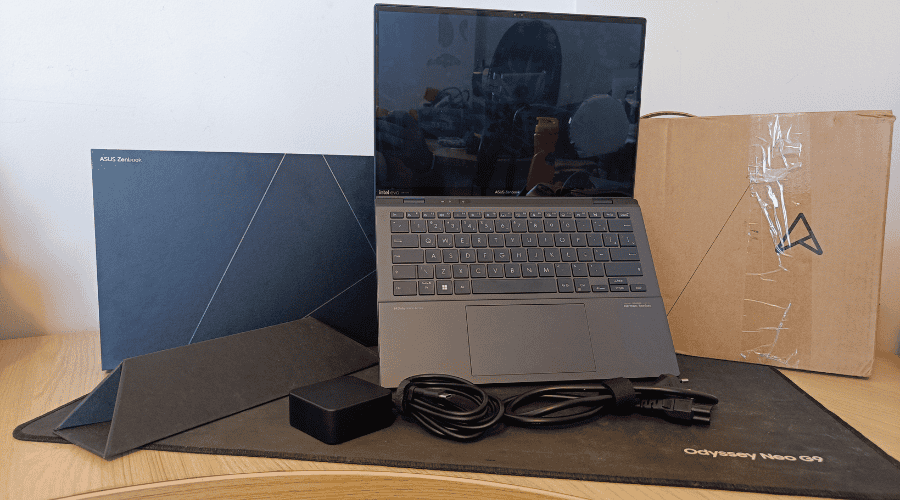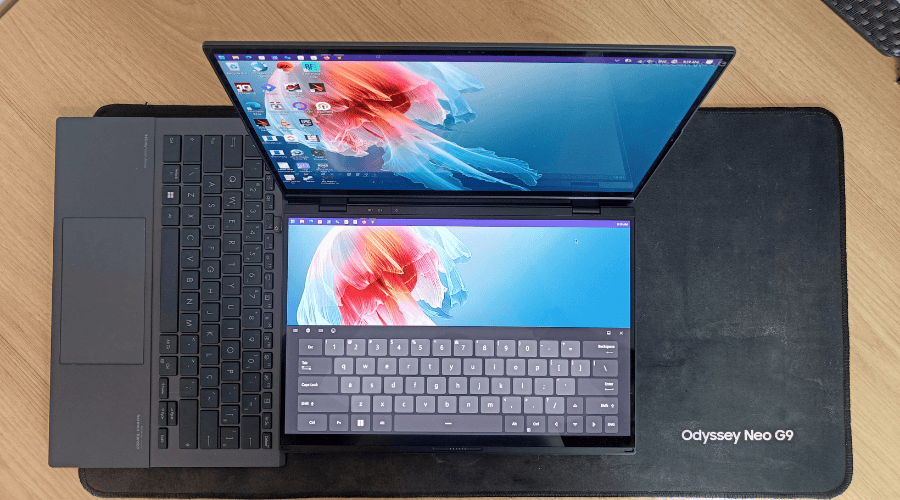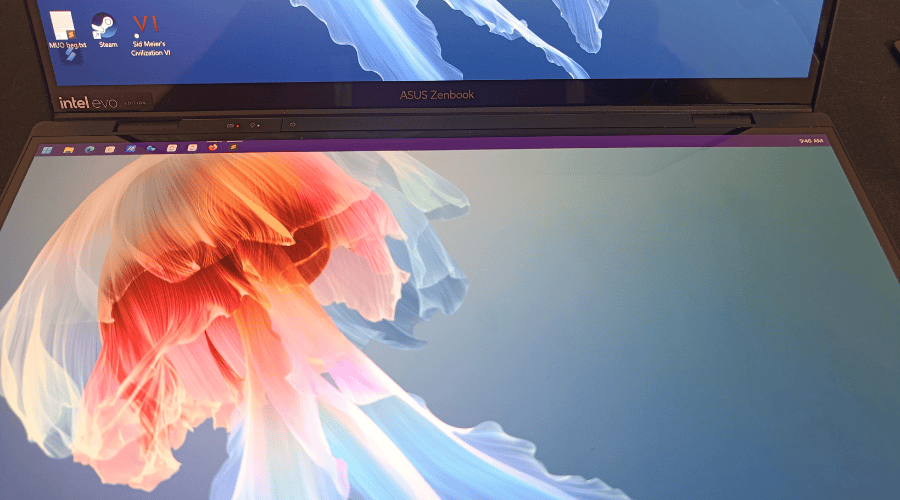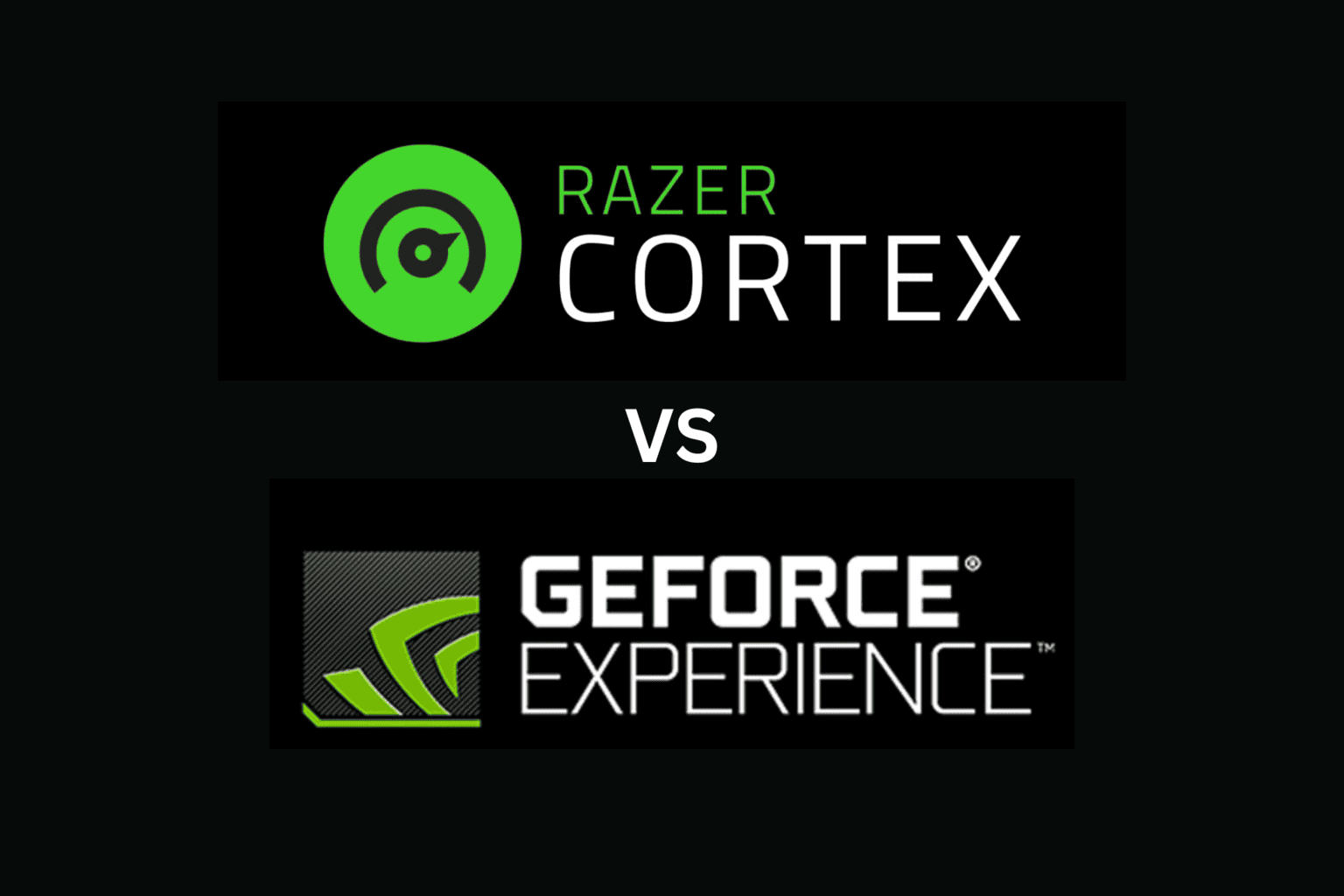Asus Zenbook Duo (2025) Review: Can I Offer You an Extra Screen In This Trying Time?
Learn about all the bits and pieces of the Asus Zenbook Duo laptop
18 min. read
Published on
Read our disclosure page to find out how can you help Windows Report sustain the editorial team. Read more

If you think most laptops don’t have enough displays, perhaps a dual-screen model suits you. This Asus Zenbook Duo review may help you decide.
Dual-screen laptop attachments are pretty popular nowadays. For some reason, people decided that a portable workstation should feature more than one display, and the idea caught on.
Not that this is a rant, I myself use two laptops and a portable monitor when working on-the-go. When working from home, there’s an additional monitor in the aforementioned setup.
So, why not make a laptop that already includes two screens? Not that the idea is new, different embodiments of it have been tried maybe dozens of times.
This one, however, doesn’t follow the usual tiny screen tightly fit somewhere approach. Asus went all-in and created a computer that could be described as two tablets wrapped together.

All about the 2024 Zenbook Duo
The 2024 Zenbook Duo model is basically an all-screen laptop, but not like the Zenbook 17 Fold OLED from 2022. The Fold was a single 17-inch foldable screen that could house a physical keyboard. The Duo includes two separate screens, though the removable keyboard remains.
And how does that combination perform, be it for work or play? I have spent a few days with the Asus Zenbook Duo to give you the answer. Check below!
Disclaimer: I received the Zenbook Duo from Asus for reviewing in late November. The company did not have access to this article before publishing, nor any input about its content. The device was returned after testing.
Comparison parameters: My main computer is a 2020 Acer Nitro 5 AN515-54-79YX (Intel Core i7-9750H, 24GB of RAM, GeForce GTX 1650, one PCIe Gen 3×4, one PCIe Gen 3×2 and one SATA SSD). I also use a 2012 13-inch MacBook Pro (Intel Core i5-3210M, 16GB of RAM, Intel HD 4000, SATA SSD) on a daily basis. In 2023, I reviewed the Asus Zenbook 17 Fold OLED. I chose to compare it with the Zenbook Duo in some aspects given the similar form-factor.
Specs
| Processor | Intel Core Ultra 9 185H (22 threads; 6 Performance cores, 2.3—5.1GHz; 8 Efficiency cores, 1.8—3.8GHz; 2 low-power Efficiency cores, 1—2.5GHz; 24MB total cache; 45-115W TDP; 34 TOPS NPU) Intel Core Ultra 7 155H (22 threads; 6 Performance cores, 1.4—4.8GHz; 8 Efficiency cores, 900MHz—3.8GHz; 2 low-power Efficiency cores, 700MHz—2.5GHz; 24MB total cache; 28-115W TDP; 11 TOPS NPU) Intel Core Ultra 5 125H (18 threads; 4 Performance cores, 1.2—4.5GHz; 8 Efficiency cores, 700MHz—3.6GHz; 2 low-power Efficiency cores, 700MHz—2.5GHz; 18MB total cache; 28-115W TDP; 11 TOPS NPU) |
| Operating System | Windows 11 Home |
| GPU | Intel Arc (Ultra 5: 7 cores, up to 2.2GHz; Ultra 7: 8 cores, up to 2.25GHz; Ultra 9: 8 cores, up to 2.35GHz), memory shared with main RAM |
| RAM | 16 or 32GB, LPDDR5X 5,600MHz |
| Storage | 1TB, PCIe Gen 4.0 |
| Battery | Advertised: up to 13.5 hours (single screen); up to 10.5 hours (dual screen) Measured: up to 8 hours (single screen); up to 6.25 hours (dual screen) | Charging time: ~100 minutes |
| Audio | Dual speakers; harman/kardon tuning |
| Camera | Full HD with IR sensor; Windows Hello support |
| Ports | 2X USB-C (Thunderbolt 4); 1X USB-A (3.2 Gen1); 1X HDMI 2.1; 1X 3.5mm audio jack |
| Wireless | Bluetooth 5.3; Wi-Fi 6E Dual-band |
| Displays | 2X OLED; 14-inch; 2,880 x 1,800 pixels; 120Hz; touch-sensitive with pen input support |
| Dimensions (WxDxH) | 31.35 x 21.79 x 1.46 ~ 1.99 cm (12.34″ x 8.58″ x 0.57″ ~ 0.78″) |
| Weight | 1.65kg (3.64lbs) with keyboard |
| Keyboard | Detachable, Bluetooth or pogo pins connection; 1.4mm key travel; touchpad |
| Body | Body | Magnesium+Aluminum alloy, gray |
| Preloaded software | MyAsus; ScreenXPert; Dolby Access |
| In the box* | Laptop, detachable keyboard, power adapter (65W), backpack, stylus; *Packaging varies by country |
Asus offers the Zenbook Duo in three Intel Core Ultra options: Ultra 5 125H, Ultra 7 155H, and Ultra 9 185H. Our review sample was the maxed-out model.
The Ultra 5 and Ultra 7 versions can be configured with 16 or 32GB of RAM, while the Ultra 9 comes with 32GB as standard. All options are soldered and can’t be upgraded after the purchase. Storage reaches from 512GB to 2TB. The Ultra 9 model also comes with a 3K (2880 x 1800 pixels) 120Hz screen, as opposed to the 60Hz Full HD (1920 x 1200) of the other variants. All panels are OLED, though, with a 16:10 aspect.
Unboxing, design and build quality

Starting with the box contents, my package felt somewhat underwhelming. In Brazil, you get the laptop (with the detachable keyboard), the charger, a magnetic foldable cardboard base, and that’s it.
Buyers in other countries will likely get some goodies. In the US, e.g., Asus throws in a backpack, a stylus, and a protective sleeve akin to an iPad Smart Cover.
Like most recent flagship offerings from Asus, the Zenbook Duo is made of a magnesium alloy. In this case, a mix of magnesium and aluminum that, according to the manufacturer, is composed of 90% recycled materials.

While its design doesn’t stand out (until the second screen is revealed) like Samsung’s Galaxy Books or Dell’s XPS line, the Zenbook Duo undeniably feels premium. The body is sturdy, though not too heavy, at about 1.65kg/3.64lbs.
Thickness is above average, at 20mm/0.78in, but the port selection makes up for it — more on that in a bit. The detachable keyboard is meant to be stored between the screens, with bas-relief seatings for that, and doesn’t add thickness.
The Zenbook Duo’s footprint could definitely be smaller: the thick bezels take much of the dual-screen format’s charm. More on that in a bit, too.

With the laptop closed, the left side houses two USB-C (Thunderbolt 4) and one USB-A (3.2 Gen 1) ports. The right side has an HDMI (2.1) output and a 3.5mm audio jack. Both sides feature cooling vents. Additional rubber feet can be seen in the Zenbook Duo’s front, for when you use it in dual-screen mode.
This is also helped by a kickstand in the computer’s bottom side, which feels very reliable, if a bit too hard to move. There are more cooling vents here, along with the speaker grilles. The top side has a matte finishing, with the Asus logo etched in a thin, glossy lining.

A single NVMe slot, occupied by whichever storage option you select for the Zenbook Duo, sits under the kickstand. You can’t add a second drive, but at least you can purchase the smallest available storage and replace it later.
The charging/power LEDs are right above the secondary screen/keyboard, and can’t be seen if the laptop is closed. The keyboard features a charging LED as well, visible from the side, but it only works for the keyboard itself.
In online forums, some users mention their keyboards arrive with a noticeable bulging. My unit didn’t had this issue, but you have been warned in case yours do.
Daily usage and connectivity
At 1.65kg, or 3.64lbs (keyboard included, the peripheral itself weighs 0.3kg/0.66lb), the Zenbook Duo is light to carry around. It’s unlikely that you’ll find that much screen for that little weight anytime soon.

Its size is comfortable, too: 31.35 x 21.79 x 1.99 cm, or 12.34″ x 8.58″ x 0.78″. I can’t help but stress again, though, that thinner bezels would have made a 15″ screen possible, instead of the 14″ panels Asus offers.
You can perfectly use the Zenbook Duo as a regular laptop, with the keyboard over the bottom panel. However, I only used it like that when playing games or watching something (more on that in a bit).
You can consider, on one hand, that I’m a bit of a display maniac: as stated previously, I work with 3-4 screens daily. On the other hand, the Zenbook Duo is undeniably targeted at display maniacs.
Consider the maxed-out model, for instance. For $200 more, you could get an Alienware m16 with similar specs, with a dedicated RTX 4060 GPU. Add another $100 and you can buy an M4 Pro MacBook Pro, if you’re willing to change your OS of choice. So, yes, I believe this model’s prospective buyers are definitely looking for an extra screen.
And, honestly, the additional screen real estate is just great. If you don’t mind the confused looks when you open your laptop like a teenager eyeing a magazine fold out poster, that is.
The wired connectivity could be better, but I have to point out something. In a reality where laptops often come with two USB-C ports and nothing else, the Zenbook Duo is excusable.

It’s guilty of lacking a dedicated charging connector, but I didn’t expect to find USB-A in this form factor. Even better, there’s even an HDMI port! If you stretch things a bit, this single laptop can have up to five screens (or more, with daisy-chaining).
If you want to be extra-safe, a simple USB-C hub with a few USB-A ports does the trick. These come a dime a dozen nowadays, like this Ugreen model for $15 with four USB-A connections (the USB-C is for power only).
Wireless connections include Wi-Fi 6E and Bluetooth 5.3. Nothing out of the ordinary, but nothing to criticize, either.
When I reviewed the Zenbook 17 Fold OLED, last year, I hated its keyboard so much I only used it for a day. I spent the next month or so relying on my own external keyboard. Asus seems to have learned the lesson, this time.
Oddly enough, both peripherals share most of the specs: 19.05 mm of key pitch and 1.4 mm of travel distance. The only significant difference is the keycaps, featuring 0.3 mm dishing on the Duo versus 0.2 mm on the Fold. Asus doesn’t mention specific of the Fold’s keyboard mechanism, though, but mentions a redesigned one on the Duo.
The Zenbook Duo’s speakers are tuned by Harman Kardon, and support Dolby Atmos spatial sound. Again, pretty much the standard for the price point, but manufacturers sometimes cheap out on laptop sound even in flagships. Asus isn’t at fault in that matter.
Screens

As always, Asus OLED screens are absolutely amazing. I do recommend, though, you spend $200 more from the base model. This way, the screen is bumped from Full HD to 3K and from 60 to 120Hz. You also get twice the RAM and a more powerful processor, so the investment is definitely worth it.
But I digress. Back to the displays, as expected of an OLED panel, colors are vivid, contrast is great, and the viewing angles is almost 180°. Brightness is decent, too, with DisplayHDR TrueBlack 500 certification. If you like to make your screens full of fingerprint smudges, they’re touch-sensitive, too.
You can’t, however, use the Zenbook Duo as a tablet. Unlike Lenovo’s Yoga Book 9i, the hinge is limited to 180°. Weirdly enough, the concept version of the 2024 Duo, called Project Precog, could flip all the way through. I do think this is a huge lost opportunity for Asus, since it severely limits use cases for the Zenbook Duo.
In online forums, there are frequent complains about a slight difference in color rendition and brightness among the displays. My review unit had this issue too, though other common problems, like wobbly keyboard and structural fragility, weren’t present.
The panels can be configured by either using the regular Windows settings or the MyAsus companion app. The latter loses most of its functionality, however, if you enable HDR in Windows. There’s also the ScreenXpert applet that allows you to customize some of the dual-screen functions. I personally found myself disabling it constantly, but your mileage may vary.

If you’re considering using the Zenbook Duo’s screens as one, to watch movies and TV shows, don’t. Remember the bezels I mentioned? They’re especially thick at the hinge, and using both panels as a single, large display is just terrible for content consumption.
To make things worse, they’re always detected as separate components. Even though you can stretch a window through them both, the moment you go fullscreen, the video only displays in one of the panels.
Performance
For daily usage, you’ll find no problem using the 2024 Zenbook Duo. Office suites, web browsing, and even some light gaming feel snappy, and most apps open near instantly. Slightly intensive tasks, like graphic design and basic video editing, are doable as well.
Graphic-intensive games and 3D modelling aren’t impossible, but don’t expect top-chart performance. The Intel Arc iGPU isn’t nearly as good as a discrete graphics card.

As a matter of comparison, check some numbers from my 2019 Nitro 5 (i7-9750H, 24GB DDR4, NVidia GTX 1650) and the 2024 Zenbook Duo (Ultra 9 185H, 32GB DDR5, Intel Arc) below. Both devices were tested with a full battery, plugged in, performance options maxed-out, and using a laptop stand with active cooling.
- PCMark 10 (general usage): 6,378 points for the Zenbook Duo; 4,074 for the Nitro 5.
- 3DMark Time Spy (graphics): 2,707 points for the Zenbook Duo; 3,265 points for the Nitro 5.
- Forza Horizon 4: 20-40 FPS (Medium graphics) for the Zenbook Duo; 40-50 FPS (Ultra graphics) for the Nitro 5.
- Battlefield 2042: 10-20 FPS (automatic graphics settings) for the Zenbook Duo — Nitro 5 wasn’t tested for this game.
Battery life and charging

Asus promises over 13 hours of battery life for the 2024 Zenbook Duo — under certain circumstances. They are: under 40% of brightness, using a single screen, playing a Full HD video, and Wi-Fi enabled, but not connected. Windows performance options were set to Balanced.
For productivity tasks, with the same settings above, the company promises eight to nine hours, depending on how many screens you use. In my testing, I was only able to reach this with a very specific setting. This was done with screen screen brightness at 50% and Wi-Fi connected. Here are my numbers:
- Performance set to power efficiency, two screens, doing office work: ~28%/hour, about 3.5 hours of battery life.
- Performance set to power efficiency, one screen, doing office work: ~26%/hour, about 4 hours of battery life.
- Performance set to power efficiency, two screens, idle: ~16%/hour, 6-6.5 hours of battery life.
- Performance set to power efficiency, one screen, idle: ~17%/hour, about 6 hours of battery life.
- Performance set to power saving, one screen, idle: ~13%/hour, about 8 hours of battery life.
The company also says that a 49-min charge fills 60% of the battery. Using a single screen, and starting at 3% (at this point Windows start threatening you to plug the laptop in, or else…), I got the following marks:
- 20 minutes: 3% to 23% (20%), tested with performance maxed-out and brightness set to 100%.
- 40 minutes: 23% to 48% (25%), tested with performance set to battery saving and brightness set to 50%.
- 60 minutes: 48% to 66% (18%), tested with performance set to battery saving and the screen of (lid closed).
- 80 minutes: 67% to 88% (21%), tested with the laptop turned off.
While fast charging for laptops isn’t a huge selling point (yet), my take is that a company has to own its marketing claims. If I had to guess, you’d need to have the laptop idle, with performance settings set to battery saving, and with the screen brightness below 40% or the lid closed, to reach the numbers Asus promises.
This isn’t an unrealistic scenario if you decide to take a (long) break while your computer charges, perhaps having a nap or preparing a meal. It’s not feasible, however, if you’re working on-the-go, using the Zenbook Duo during the charging, and wanting to be strapped to a power outlet for the shortest time possible.
Now, think with me: the former situation is relatable to working comfortably at home or in your office. In these cases, you’re likely to have a second screen (maybe even more), and there’s a good chance it’s larger than the Zenbook Duo’s displays. The laptop’s major selling point is nullified in this case — you can grab something with better specs and a huge monitor at this price point.
The latter, on the other hand, represents more likely scenarios where someone would benefit from a two-screen laptop: working, e.g., from a coffee shop or an airport’s boarding area. In these cases, having a more powerful charger would make much more sense.
Competitors and final words

I don’t have significant complains about the 2024 Zenbook Duo. It’s a decent work-oriented laptop, which doesn’t promise blazing-fast performance, but offers a fully sized secondary screen to justify its price tag. The speakers are a great, unexpected bonus, and the port selection is acceptable.
The lack of a tent (as Lenovo calls it) or tablet mode is undeniably a huge con. The average (at best) battery life, and the also average (at best) charging times, are hard to ignore as well.
These issues make me believe Asus didn’t really think for whom the 2024 Zenbook Duo was being designed for. It seems to come only as an answer to Lenovo’s Yoga Book 9i, by leveraging the already-known Zenbook Duo brand name.

Speaking of which, let’s consider Lenovo’s alternative. The company has updated the 9i’s internals earlier this year, but it still uses a weaker processor (than the Zenbook’s weakest option), a Core Ultra 7 155U. The screens are similar, though slightly smaller, at 13.3″ each, and refresh at 60Hz only.
While Lenovo keyboards are famed for their comfort, the Yoga Book’s implementation leaves a lot to be desired. It doesn’t have backlight, nor a touchpad, and needs to be stored outside the laptop, separately. Port availability is also a concern: the Yoga Book 9i has three USB-C connections and that’s it. You don’t get even a 3.5 mm jack. Lastly, there’s the price: if you think the Zenbook Duo is expensive, it begins to look quite reasonable compared to the Yoga Book 9i’s $1,800 starting MSRP.
It has a few advantages over the Zenbook Duo, though: the 360° hinge, for starters. There’s also a privacy shutter for the camera, and the included foldable stand has multiple functions. Not only it offers a few different positions (though the Zenbook Duo’s kickstand is more flexible on that aspect), it also holds the included stylus and serves as a cover for the keyboard. The design, with rounded edges all-around, is also more to my liking, but this is a matter of personal taste.

If you don’t need your secondary screen to be that large, and money isn’t an issue, the Zenbook Pro Duo, also from Asus, may be your best choice. It features an older CPU, the i9-13900H, which performs basically the same as the Ultra 9 185H, but lacks the AI bits. For some, like me, this is actually a pro. Memory is 32GB of DDR5 RAM, with a 1TB PCIe 4.0 SSD. It features a dedicated graphics card: an NVidia RTX 4050, not the most powerful around, but definitely better than an iGPU.
The main screen is similar to the 2024 Duo’s. The secondary screen has a 2,880 x 864 pixels resolution. Both support stylus and finger input. The keyboard is a little bit cramped, too, with the touchpad next to it. People whose OCD triggers when regular laptops feature off-center touchpads will be terrified by this arrangement.
Port selection is exactly the same as in the 2024 Duo, but there’s a dedicated power connector, so you don’t need to waste one USB-C while charging, and there’s a microSD card reader, too. The packaging includes a backpack, a stand, and a stylus. Asus also provides a complimentary palm rest, to compensate the lack of one in the laptop itself. It costs a hard-to-swallow $2,500.

For a bit less than that — $2,449 — you can purchase Lenovo’s ThinkPad X1 Fold. It’s a different form factor, I know, but one that may serve your needs. If the i7-1250U CPU performs as terribly on the X1 Fold as it does inside the Zenbook Fold, you’ll find yourself often wondering why is it even labeled as an i7. RAM caps at 32GB, though it’s hard to find this version on sale, and there is 512GB of storage.
Just like its non-folding sibling, you get three USB-C ports (two Thunderbolt 4, one 3.2 Gen2), but there’s a physical volume button and an optional nanoSIM slot. The display switches from a 16.3″ 4:3 2,560 x 2,024 when unfolded to a 12-inch 3:2 2,024 x 1,280 with the detachable keyboard on. It isn’t, however, included in all versions. The packaging also has a stylus, if that’s any consolation.
Judging by how both Lenovo and Asus refrained from launching new foldable laptops, I would guess this niche is dead — for now. Dual-screen models, on the other hand, may be a stop-gap for people who don’t want to choose between portability and screen size, at least until the cost of large foldable OLED panels goes down.

The Ultra 9 variant of the 2024 Zenbook Duo offers decent performance to consider the model a viable option for those wanting a dual-screen laptop. However, if this makes it worth $1,700, it’s up to you. For that kind of price, I would much rather get an Snapdragon X Elite-powered laptop, which offers great performance and battery life, and a separate portable monitor. In the Zenbook Duo’s case, though, you’re not only paying for the portability, but for the convenience of having both displays built-in as well.
I hope that you enjoyed my Asus Zenbook Duo review and I hope that it provided sufficient information if you’re thinking of buying it.
If you already did, share your experience in the comments below.









User forum
0 messages